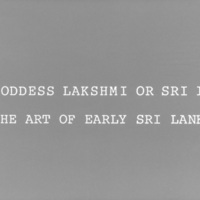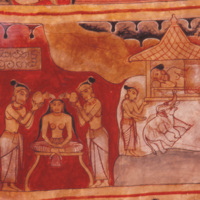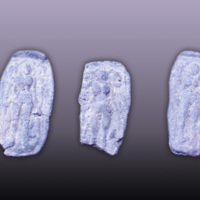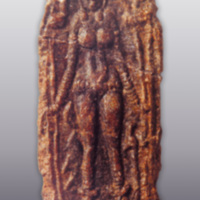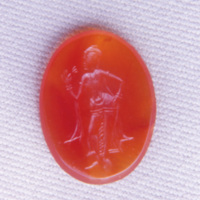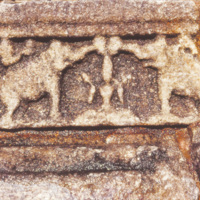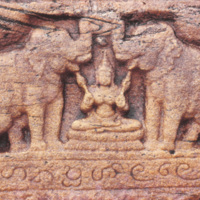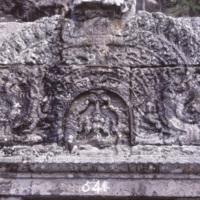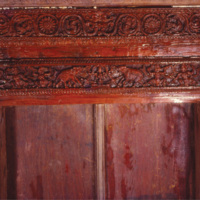Main Menu
AORC Libraries
Browse Items in Goddess Laksmi or Shri in the Art of early Sri Lanka (16 total)
Goddess Lakshmi or Shri
Description: Goddess Lakshmi or Shri in the art of early Sri Lanka- Common to both Buddhist and Hindu art in India as well as Sri Lanka is Lakshmi or Shri, the goddess of prosperity. The most popular motif in which she figures is that of ‘Gajalaksmi’ in which the goddess sits or stands on a lotus while two elephants holding pots pour water over her head. The earliest appearance of the Gajalaksmi symbol in India is in the Buddhist sculpture at Bharhut and later Sanchi. This has even led to the view that the motif is symbolic of the birth of the Bodhisattva.
Contributor: Co-Author: Seneviratna, Harsha
Collection: Women in Sri Lankan Sculpture and Painting
Queen Mahamaya, bathed by attendants.
Description: This painting, depicting the bathing of queen Maya, is reminiscent of the Gajalaksmi symbol in which the goddess sits or stands on a lotus while two elephants holding pots pour water over her head. It was found among the paintings at Dambulla, Sri Lanka, that show Queen Maya in scenes associated with the Bodhisattva's birth.
Contributor: Co-Author: Seneviratna, Harsha
Collection: Women in Sri Lankan Sculpture and Painting
Copper plaques with the Gajalakshmi symbol
Description: These copper plaques with the Gajalaksmi symbol of prosperity are known to have been used as currency in Sri Lanka during the early centuries of the Christian era. Several examples are seen among the exhibits of the National Museums of Colombo and Kandy, Sri Lanka.
Contributor: Co-Author: Seneviratna, Harsha
Collection: Women in Sri Lankan Sculpture and Painting
Copper plaques with Lakshmi
Description: This copper plaque is considered a Laksmi plaque, even though the goddess Laksmi is shown without the usual accompanying elephants. The plaque was probably used as currency and was discovered during excavations at the Vijayabahu palace site in Anuradhapura, Sri Lanka in 1985. It is presently with the Department of Archaeology, Colombo, Sri Lanka.
Contributor: Co-Author: Seneviratna, Harsha
Collection: Women in Sri Lankan Sculpture and Painting
Lakshmi carved on a carnelian gemstone
Description: This is an example of the numerous seals of early Sri Lanka, where the female figure is used as a symbol of good fortune. Engraved on carnelian stone of oval shape and found at Kantorodi, Jaffna, Sri Lanka, it may be of early date. The seal is in a private collection, Colombo.
Contributor: Co-Author: Seneviratna, Harsha
Collection: Women in Sri Lankan Sculpture and Painting
Gajalakshmi
Description: In Sri Lanka, as in India, the Gajalaksmi is used as an auspicious symbol on the lintels of doors at the main shrine. This stone relief of the Gajalaksmi over the entrance doorway at the Nalanda Gedige in the Matale district, Sri Lanka, belongs to the 8th century A.D.
Contributor: Co-Author: Seneviratna, Harsha
Collection: Women in Sri Lankan Sculpture and Painting
Gajalakshmi
Description: This stone carving of Gajalaksmi on a door lintel at the Isurumuniya temple in Anuradhapura, Sri Lanka, may belong to the latter half of the Anuradhapura period. Although of modest dimensions, its central position on the door frame is noteworthy.
Contributor: Co-Author: Seneviratna, Harsha
Collection: Women in Sri Lankan Sculpture and Painting
Gajalakshmi
Description: Belonging to the 12th century is this relief of the Gajalaksmi from Polonnaruva, Sri Lanka. King Nissankamalla thought it auspicious to embellish his ‘Book of stone’ or Galpota, Sri Lanka, with the Gajalaksmi symbol.
Contributor: Co-Author: Seneviratna, Harsha
Collection: Women in Sri Lankan Sculpture and Painting
Gajalakshmi
Description: Belonging to the 13th century is this Gajalaksmi motif on a makara arch from Yapahuva, Sri Lanka. Two such stone reliefs flank the main entrance doorway.
Contributor: Co-Author: Seneviratna, Harsha
Collection: Women in Sri Lankan Sculpture and Painting
Gajalakshmi
Description: Dating to the 14th century is this Gajalaksmi motif at the centre of the wooden door lintel at Uda Aludeniya temple in Gampola, Sri Lanka.
Contributor: Co-Author: Seneviratna, Harsha
Collection: Women in Sri Lankan Sculpture and Painting



